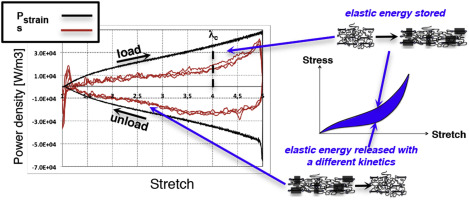Polymer ( IF 4.1 ) Pub Date : 2017-08-30 , DOI: 10.1016/j.polymer.2017.08.059 J.-B. Le Cam

|
Strain-induced crystallization is classically assumed to be responsible for the hysteresis loop observed in the mechanical response of cis-1,4-polyisoprene. The aim of the present study is to investigate where does this energy go. Energy balances carried out using infrared thermography have shown that the hysteresis loop is due neither to intrinsic nor thermal dissipation, but is entirely used by the material to change its microstructure. Thus, significant changes in the internal energy accompany SIC. Experiments performed show that the mechanical energy brought to deform the material is stored elastically in the amorphous phase (chain alignment and accumulation of topological constraints in the crystallite vicinity) and is released with a different kinetics during crystallite melting. The demonstration that NR is able to store mechanical energy without converting it into heat is a realistic way to explain its extraordinary resistance to crack growth.
中文翻译:

天然橡胶中的应变诱导结晶导致的能量存储:机械滞后的物理原因
传统上认为应变诱导结晶是顺式机械反应中观察到的磁滞回线的原因-1,4-聚异戊二烯。本研究的目的是研究这种能量的去向。使用红外热像仪进行的能量平衡表明,磁滞回线既不是由于固有损耗也不是由于热耗散,而是由材料完全用来改变其微观结构。因此,内部能量的重大变化伴随着SIC。进行的实验表明,使材料变形的机械能被弹性地存储在非晶相中(链对齐和微晶附近拓扑约束的积累),并在微晶熔化期间以不同的动力学释放。NR能够存储机械能而不会将其转化为热量的证明,是一种现实的方法,可以解释其对裂纹扩展的非凡抵抗力。









































 京公网安备 11010802027423号
京公网安备 11010802027423号